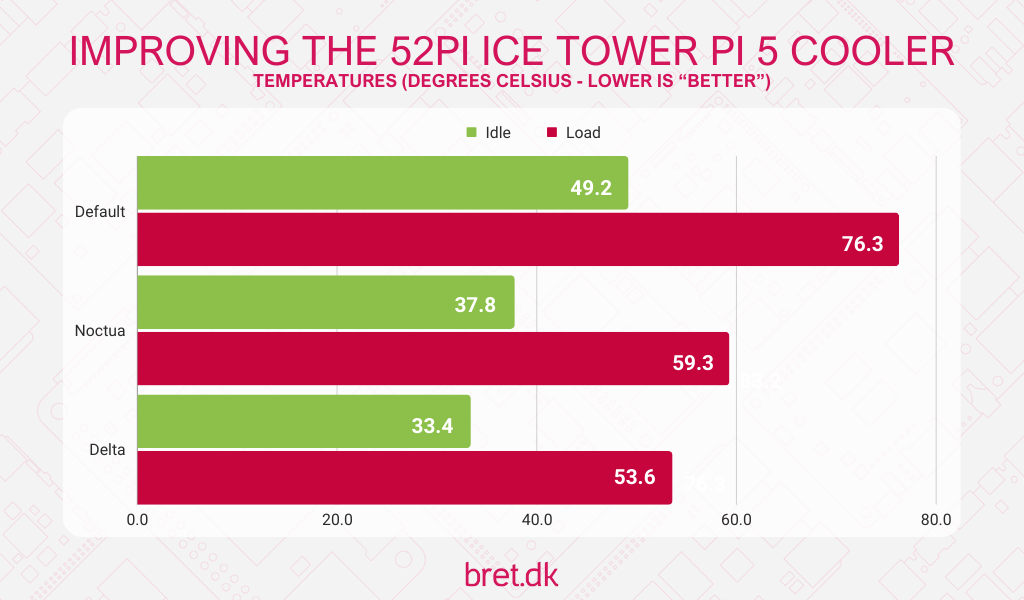It’s no secret that I loved the 52pi ICE Tower cooler when I reviewed it a little while ago, and if you can fit it into your case or overall aesthetic then it offers some of the best cooling of an aftermarket Raspberry Pi 5 cooler.
After the review though, with it sat on my desk staring at me, I saw my Noctua 40mm fan out of the corner of my eye. That’s when the intrusive thoughts kicked in, and I went down a rabbit hole of trying to find suitable fans I could strap to this thing and figure out just how low can we go.
Table of Contents
Improve the 52pi ICE Tower: The Challengers
The default fan that comes with the 52pi ICE Tower Cooler is by no means bad, and it performs well all things considered. It also has a big advantage in this test (which is why I’ll state now that this is not meant to be a scientific, super controlled test, and was born more out of a meme than anything else) in that it comes with the QUIC header that slots right into the Raspberry Pi 5’s fan header, so it’s controlled and powered directly by the board.
Moving on to the 1st challenger though, we have the Noctua NF-A4x20 5V which is a 40x20mm PWM fan with a standard 4-pin connection. For this test though, I’ll be powering it via USB so goodbye PWM controls and hello power (insert Jeremy Clarkson GIF here).
The 2nd of the USB-powered challengers is on a slightly different level and required me to scour the internet to find someone willing to sell me just a couple of units. Turns out I’m a little stupid and I could have just ordered them at DigiKey but I didn’t look hard enough on my first attempt. You live and learn. In the end, I went with a Delta Electronics EFB0405VHD-F00 which is really, a very sexy name. It’s another 5V 40x20mm fan that I hooked up to a USB connection as that’s all I had to hand.
The Test Setup
As I mentioned, this isn’t supposed to be super technical as I’m not able to replicate conditions exactly. Though even with the default fan, when under full load and it hits the pre-defined temperature, it will run at 100% fan speed so realistically, the full load temperature tests are on somewhat of an equal playing field, but the idle tests were not. Did I care enough to change the fan curve so that the default fan ran at 100% all the time? I can confirm I did not, and for that, I kind of apologise, but did I mention this wasn’t meant to be technical?
For the actual testing though, the idle temperatures are taken from a clean boot of the system and waiting 15 minutes for things to normalise. Load testing was done with stress-ng and –matrix 0, with the temperatures measured after 15 minutes of full load. All, as always, whilst using the performance CPU governor and an ambient room temperature of 25 degrees Celsius.
The Results
Much to everyone’s surprise, faster, more powerful fans equals better performance!

But Wait… There’s more!
OK, so as a last-minute addition to this, I know I’ve bleated on about it not being technical and blah blah, but I opened a drawer looking for something else yesterday and I saw everything I’d need to power and run each of these fans through the Raspberry Pi 5’s fan header.
After butchering a Noctua 4-pin fan extension cable and sacrificing the cable off a spare Raspberry Pi 5 Active Cooler fan (RIP) to stick them together, I then had everything I needed to run the tests again.
As expected, things don’t change too much and the Noctua still looks like the best all-round option. The asterisk on the Delta’s idle temperature is because the fan didn’t have a speed/tach cable so it ran at its full speed, and for those of you interested, it drew 1.7 watts doing so.
Conclusion
Whilst this was born out of a joke and was meant to be lighthearted rather than something to genuinely base purchase decisions on, I think with the data, we can say that the Noctua NF-A4x20 may actually be a solid purchase if you want to push even better cooling performance out of your 52pi ICE Tower Cooler.
Sure, even though the default fan included with the cooler prevents it from throttling the CPU frequency even under full load, the addition of the Noctua fan gives you an additional 10-17 degrees of headroom for potential overclock attempts. That and it just gives you lower numbers on a graph if that’s what you’re into.
The Delta Electronics fan, whilst fun to play with, isn’t really a viable option in this use case and I think we all knew that as soon as I mentioned what I was going to do. It draws 1.7 Watts (0.34A at 5V) so eats into your power budget and it spins fast and loud at that power draw. I did all of my testing around 40cm away from my ears and I don’t think I’ll be getting that sound out of my head for a few days.
Do yourself a favour. If you want to swap out the fan, get the Noctua and a conventional 4-pin fan to 1mm JST convertor and let your Pi live its best life.